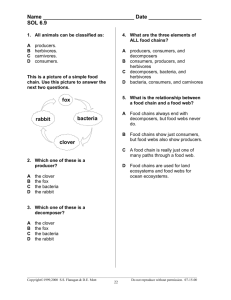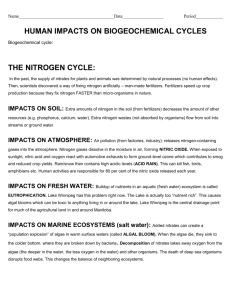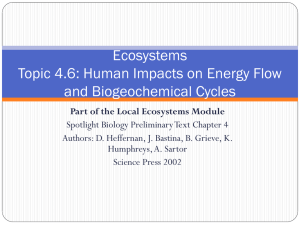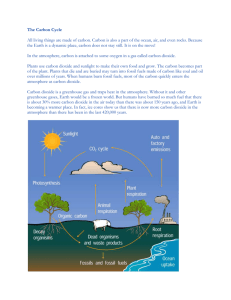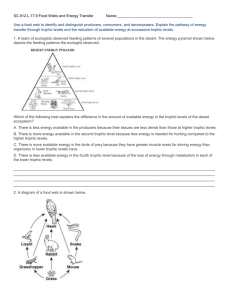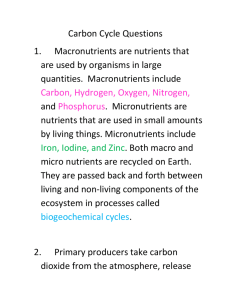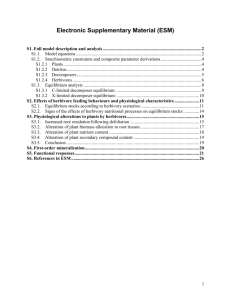Chapter 28 Practice Questions
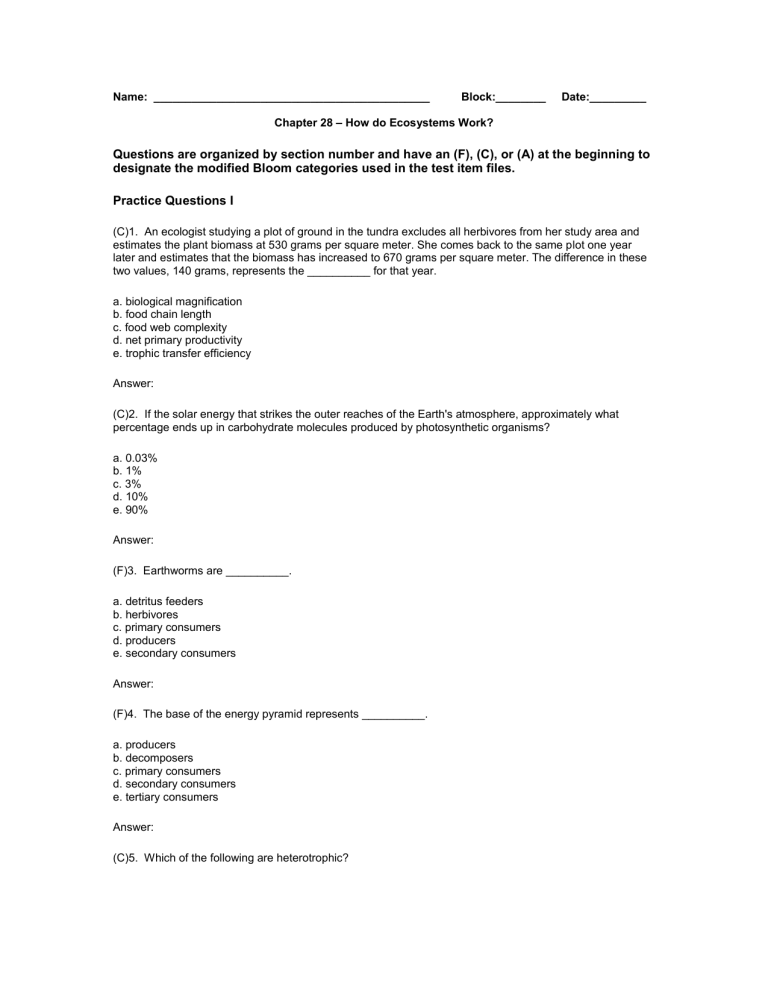
Name: ____________________________________________ Block:________ Date:_________
Chapter 28
– How do Ecosystems Work?
Questions are organized by section number and have an (F), (C), or (A) at the beginning to designate the modified Bloom categories used in the test item files.
Practice Questions I
(C)1. An ecologist studying a plot of ground in the tundra excludes all herbivores from her study area and estimates the plant biomass at 530 grams per square meter. She comes back to the same plot one year later and estimates that the biomass has increased to 670 grams per square meter. The difference in these two values, 140 grams, represents the __________ for that year. a. biological magnification b. food chain length c. food web complexity d. net primary productivity e. trophic transfer efficiency
Answer:
(C)2. If the solar energy that strikes the outer reaches of the Earth's atmosphere, approximately what percentage ends up in carbohydrate molecules produced by photosynthetic organisms? a. 0.03% b. 1% c. 3% d. 10% e. 90%
Answer:
(F)3. Earthworms are __________. a. detritus feeders b. herbivores c. primary consumers d. producers e. secondary consumers
Answer:
(F)4. The base of the energy pyramid represents __________. a. producers b. decomposers c. primary consumers d. secondary consumers e. tertiary consumers
Answer:
(C)5. Which of the following are heterotrophic?
a. producers b. decomposers c. primary consumers d. secondary consumers e. The second, third, and fourth answers are all correct.
Answer:
(C)6. Of the following trophic levels, which would support the fewest organisms? a. producer b. decomposer c. primary consumer d. secondary consumer e. tertiary consumer
Answer:
(F)7. Which of the following trophic levels is always the final link in the food chain? a. producer b. decomposer c. primary consumer d. secondary consumer e. tertiary consumer
Answer:
(F)8. Which of the following nutrients remains chemically the same as it is cycled through the food chain and is generally not used in the synthesis of new molecules? a. water b. carbon c. nitrogen d. phosphorus e. Both the third and fourth answers are correct.
Answer:
(F)9. In the carbon cycle, carbon (C) is returned to the atmosphere by __________. a. photosynthesis b. evaporation of water c. burning of fossil fuels d. respiration of plants and animals e. The third and fourth answers are both correct.
Answer:
(F)10. For which of the following nutrients is rock a major reservoir? a. water b. oxygen c. carbon
d. nitrogen e. phosphorus
Answer:
(F)11. How is nitrogen released back to the atmosphere once it has been incorporated into the body of an organism? a. nitrogen fixation b. through a process involving a symbiotic association with a legume c. by decomposers and denitrifying bacteria d. Both of the first two answers are correct.
Answer:
(F)12. Which of the following is/are a major contributor to the problem of acid deposition? a. oxygen b. carbon dioxide c. sulfur dioxide d. nitrogen oxides e. Both the third and fourth answers are correct.
Answer:
(F)13. So far, global warming has been documented to be causing __________. a. changes in precipitation patterns on land, with some areas subjected to more severe and frequent droughts, and other areas more frequent and severe floods b. melting of ice sheets and retreat of glaciers at unprecedented rates c. shifts in the distribution and abundance of a number of plant and animal species d. shifts in the timing of spring events, which are occurring much earlier than previously e. all of the above f. None of the above. To date, global warming has had no effects on any of the things mentioned above.
Answer:
(C)14. How does using wood derived from trees as a source of fuel for cooking affect the carbon cycle? a. It decreases the uptake of CO
2
from the atmosphere as there are fewer trees carrying on photosynthesis. b. It has no effect on the carbon cycle. c. It increases the release of CO
2
into the atmosphere as the wood is burned. d. Both the first and third answers above are correct.
Answer:
(F)15. Increased levels of carbon dioxide and other greenhouse gases in the atmosphere contribute to global warming by: a. allowing more sunlight to reach the Earth. b. preventing more of the heat radiated from the Earth's surface from escaping into space. c. promoting and sustaining forest fires and other forms of combustion that release heat.
Answer:
Practice Questions II
(C)1. DDT and other substances that undergo biological magnification are dangerous because they are
__________. a. biodegradable b. not biodegradable c. fat soluble d. water soluble e. Both the second and third answers are correct.
Answer:
(F)2. A spider that feeds on an aphid that in turn feeds on germinating blades of wheat would belong to what consumer category? a. herbivore b. primary consumer c. secondary consumer d. tertiary consumer
Answer:
(C)3. Which of the following animals are omnivores? a. deer b. wolves c. hyenas d. black bears e. fungi
Answer:
(C)4. What are the primary consumers of the ocean environment? a. phytoplankton b. zooplankton c. small fish such as anchovies d. big fish such as tuna e. jellyfish
Answer:
(C)5. Which of the following organisms is considered to be a detritus feeder or decomposer? a. bacteria b. worms c. fungi d. all of the above
Answer:
(F)6. What is the base of the food pyramid or the food chain in a marine ecosystem? a. plankton b. zooplankton c. phytoplankton
d. small fish e. coral
Answer:
(F)7. Organisms that eat dead or decaying material to gain their source of energy are called __________ or
__________. a. autotrophs; consumers b. consumers; producers c. detritivores; herbivores d. detritus feeders; decomposers
Answer:
(C)8. As one moves from the equator towards the poles, the net primary productivity of forest ecosystems generally __________. a. decreases b. increases c. remains the same d. first decreases and then increases e. first increases and then decreases
Answer:
(F)9. Which trophic level has members that require uptake of ammonia, a complex form of nitrogen? a. producers b. herbivores c. carnivores d. decomposers
Answer:
(C)10. In ecosystems, elements like carbon and nitrogen: a. are neither created nor destroyed, but may change molecular form as they pass from organism to organism and between abiotic and biotic components. b. are produced by the sun, travel to Earth, and pass briefly through ecosystems, being degraded in the process, and are ultimately lost to space. c. play no role whatsoever.
Answer:
(F)11. Which of the following materials cycle through an ecosystem: 1) carbon, 2) nitrogen, 3) oxygen, 4) water, and 5) energy? a. 1 through 5 b. 1 through 4 c. 1 through 3
d. only 1 and 2 e. only 4 and 5
Answer:
(F)12. Why is acid rain, or acid deposition, considered to be harmful? a. Moisture in the air becomes acidified and then falls on plants and the soil below, harming them. b. Acid rain leeches essential nutrients out of the soil (e.g., potassium and calcium), and kills decomposers in the soil. c. Dead, or weakened, plants make the soil much more susceptible to erosion. d. all of the above
Answer:
()13. Which of the following greenhouse gases does phytoplankton in the marine environment require for the process of photosynthesis, thereby assisting in the regulation of Earth's atmospheric composition? a. oxygen b. hydrogen c. carbon monoxide d. carbon dioxide e. sulfur dioxide
Answer:
(F)14. Which of the following is NOT considered to be a greenhouse gas? a. oxygen b. water vapor c. methane d. carbon dioxide
Answer:
(C)15. Conserving electricity by using fluorescent lights instead of incandescent lights and turning off lights and appliances when not in use __________. a. actually increases greenhouse gas production as the predominant fossil fuel
–powered electrical generating plants consume large quantities of carbon dioxide when they are operating b. has no effect on greenhouse gas production because nearly all electricity in this country is produced by nuclear reactors and renewable wind and solar generating stations c. helps reduce greenhouse gas production because the majority of electricity in this country is still produced by fossil fuel –powered generating plants. Since these plants produce carbon dioxide when they operate, conserving electricity reduces greenhouse gas production.
Answer:

